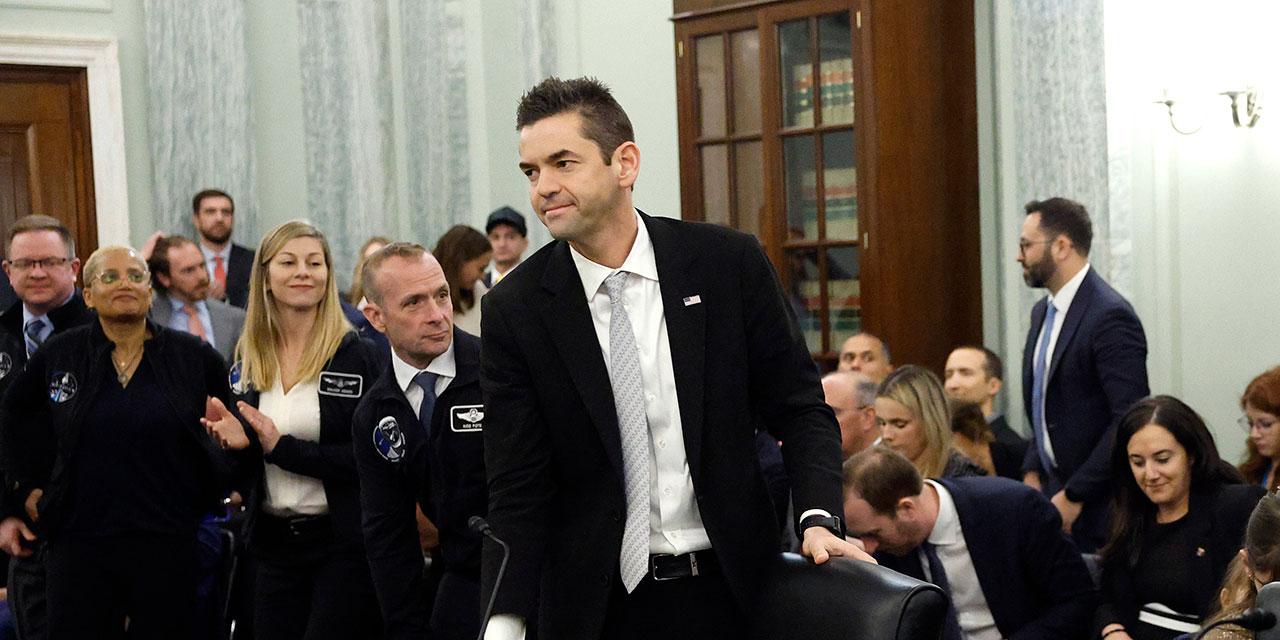
Jared Isaacman, President Trump’s nominee to become NASA administrator, walked a political tightrope in his Wednesday confirmation hearing before the U.S. Senate Committee on Commerce, Science, & Transportation. Isaacman is an unconventional choice to run the national space agency; he lacks formal engineering training and is an outsider to both Washington and the traditional space establishment. Nonetheless, the billionaire entrepreneur, pilot, and private astronaut enjoys widespread support from space advocates. That’s partly due to his two impressive, self-funded missions, the most recent of which included the first civilian spacewalk.
But can Isaacman navigate the more treacherous terrain of Washington, D.C.? His confirmation seemed almost assured going into the hearing, and his mostly confident performance helped his cause. Still, NASA and space industry insiders watched his testimony closely, seeking clues to where he might take the troubled space agency.
Finally, a reason to check your email.
Sign up for our free newsletter today.
NASA faces wrenching policy decisions. Its Artemis program, which aims to return U.S. astronauts to the moon—and send them, eventually, to Mars—is running far behind schedule. The massive Space Launch System (SLS) rocket meant to carry those astronauts is outdated and wildly over budget—“a national disgrace,” in one analyst’s words. Some experts advise cancelling the SLS program outright.
Elon Musk, of course, has long argued that the U.S. should skip a lunar return altogether and go “straight to Mars.” When President Trump said the U.S. would “plant the stars and stripes on the planet Mars” in his second Inaugural Address, Musk gave a thumbs up. Was the president abandoning the Artemis lunar program that was a hallmark of his first term? Was Musk now effectively in charge of U.S. space policy?
Senators wanted answers. Artemis and the Space Launch System (SLS) enjoy broad support on Capitol Hill, in part because they direct substantial funding to states with major NASA facilities. With China openly pursuing plans to build a lunar base, many lawmakers also view an American return to the moon as a matter of national security and international prestige. Both Democrats and Republicans on the Senate committee sought reassurance that NASA’s lunar ambitions would remain on track—and that Isaacman wouldn’t simply serve as a proxy for Elon Musk, who recommended him for the role.
The nominee largely put those concerns to rest, though some wobbles suggested behind-the-scenes turbulence from the White House. In private meetings ahead of the hearings, Isaacman reportedly voiced strong support for a moon mission. Texas senator Ted Cruz, who chairs the committee, posted on X that Isaacman was “committed to having American astronauts return to the lunar surface ASAP.”
In the written testimony Isaacman submitted in advance of his hearing, however, the nominee wrote, “As the President stated, we will prioritize sending American astronauts to Mars. Along the way, we will inevitably have the capabilities to return to the moon and determine the scientific, economic, and national security benefits of maintaining a presence on the lunar surface.” The not-so-subtle pivot suggests a scramble to better align his words with the president’s stated goals.
When senators pressed him during his verbal testimony, Isaacman split the difference. “We don’t have to make a binary decision” between the moon and Mars, he said, adding: “We could be paralleling these efforts.”
Senators also pressed Isaacman to clarify his position on the controversial Space Launch System (SLS) rocket. To date, SLS has completed only one uncrewed test flight, in 2022. According to NASA’s current timeline, SLS is set to carry four astronauts around the moon next year on the Artemis II mission, with the Artemis III mission—featuring a lunar landing party—optimistically scheduled for 2027.
Republican senator Jerry Moran of Kansas asked whether Isaacman was fully committed to this plan. “This is the current plan,” Isaacman replied. “I do believe it is the best and fastest way to get there.” Underscoring his support, Isaacman had invited the four Artemis II astronauts to attend the hearing with him.
Of course, Isaacman knows what many senators would rather not admit: NASA can’t afford to fly the SLS more than a few times. The agency’s inspector general estimates that each launch of the old-school, non-reusable rocket will cost over $4 billion. “I don’t think [SLS] is the long-term way to get to and from the moon and Mars with great frequency,” Isaacman told the committee, “but this is the plan we have now.”
Isaacman signaled that he—and presumably the White House—supports using SLS through the Artemis III mission. “We’ve got to get this crew around the moon,” he said, gesturing to the Artemis II astronauts seated behind him, “and the follow-on crew to land on the moon.” After that, he implied, NASA will need a new approach.
Though the topic didn’t come up in the hearing, the most likely alternative to SLS will involve the SpaceX Starship—Musk’s gargantuan, fully reusable rocket, which is still in its rocky test phase. NASA already depends on SpaceX Falcon 9 rockets to fly crews back and forth to the International Space Station (ISS) in a cost-saving program called Commercial Crew. If Starship eventually proves safe and reliable enough to fly NASA astronauts, it will be able to deliver them to the moon and beyond for a tiny fraction of what SLS flights would cost.
NASA’s public-private partnership with SpaceX has been a major win for taxpayers—but it’s increasingly a sore spot for Democrats, who bristle at Elon Musk’s outsized influence in the Trump administration and his brash partisanship.
Heading into the hearing, Isaacman needed to create some distance between himself and the flamboyant entrepreneur widely seen as his patron. Asked whether he had spoken or texted with Musk since his nomination, Isaacman replied, “Not at all, Senator.”
Some Republicans also appear irritated by Musk’s outsize influence. And they worry that Musk’s Mars-centric vision for U.S. space policy will strip resources from current NASA programs. In addition to urging the end of the Artemis lunar program, for example, Musk also recently advised deorbiting the ISS years before its scheduled 2030 retirement.
In contrast, Isaacman told the senators, “I do not think we should deorbit it now.” Instead, he said he wants to “use up every bit of capability” the aging space station still has. Space analyst Rand Simberg noted that Isaacman “clearly separated himself from Elon on both the moon and ISS.”
One of Isaacman’s shakier moments, however, came when Democratic senator Ed Markey of Massachusetts pressed him on Musk’s role in the nomination. Asked whether Musk was in the room at Mar-a-Lago when Trump offered him the job, Isaacman sidestepped. “My meeting was with the president of the United States,” he repeated. The answer came off as evasive—and is likely to resurface in political attacks for years to come.
Isaacman spoke with genuine passion about space exploration and his belief that NASA can still take on “near-impossible” missions. But he left himself strategic flexibility on the details. How soon will NASA pivot to Mars? Will it continue pursuing an ambitious lunar base? Those questions are likely still being worked out behind the scenes—and much may depend on how much influence Musk retains with the president in the months ahead. Of course, most of the missions under discussion will unfold long after Trump leaves office, giving future administrations a significant role in shaping NASA’s direction.
The senators took pains to remind Isaacman that Congress holds NASA’s purse strings, and that lawmakers jealously guard programs that benefit their constituents. Several senators opened their remarks by listing the NASA programs in their states and seeking reassurances that those would continue. Senator Cruz emphasized that Congress sets NASA’s mission priorities, citing legislation passed during the first Trump administration that calls for a “sustained human presence” on or near the moon as a “stepping-stone” to later Mars ventures. “If that is the law, then I’m committed to it,” Isaacman conceded after Cruz hammered the point home several times.
One of Isaacman’s biggest challenges at NASA will be navigating a Congress long accustomed to micromanaging the agency’s programs—even down to dictating technical requirements for space hardware. (Space insiders jokingly refer to SLS as the “Senate Launch System.”) Despite his lack of political experience, Isaacman showed good instincts in handling this kind of pressure. When Senator Cruz asked whether he supports canceling the Lunar Gateway—a proposed space station intended to orbit the moon—the nominee declined to be pinned down.
A number of space experts recommend cancelling that expensive program. Many also advise retiring the SLS rocket after the Artemis III mission, if not sooner. Vehicles flown by SpaceX and other private companies will soon be able to provide more frequent and affordable access to the moon. (In a forthcoming Manhattan Institute issue brief, I concur with those recommendations.)
Isaacman is wise to keep his options open. But he and the White House will still have to get Congress on board with major changes. Republican lawmakers have ceded to the president unprecedented authority over trade. But they could insist that major changes in space policy require new legislation. After all, unlike trade, space appears to be a secondary priority for the president. In a recent Fox News interview, Trump mentioned interest in going to Mars. “Is it number one on my hit list?” he asked rhetorically. “No. It’s not really.” Still, he added, “It would be a great thing if we could do it.”
Isaacman’s second major challenge, if confirmed, will be managing NASA itself. He described the agency as “a struggling organization full of good people,” and said he looks forward to working with “the best and the brightest.” But he also made clear that he wants to shift NASA’s culture toward “ownership and accountability.” The agency, he testified, must address the issues “that are causing everything to take longer than it should and cost more than it should.”
Isaacman’s entrepreneurial background may serve him well in the daunting task of restructuring NASA into a more “mission-focused” organization. Once the SLS is retired, NASA will no longer be in the rocket-building business. Its future will depend on a pivot toward advanced research—Isaacman emphasized nuclear propulsion—and more ambitious manned and unmanned missions. “We will launch more telescopes, more probes, more rovers, and endeavor to better understand our planet and the universe beyond,” he testified.
The vote on Isaacman’s nomination is expected in the coming days. The next NASA administrator will have to steer the agency through painful—but promising—changes, manage Congressional resistance, and stay in sync with the ever-unpredictable occupant of the Oval Office. Isaacman may be just the right man for this near-impossible mission.
Photo by Kevin Dietsch/Getty Images News via Getty Images
Source link
















